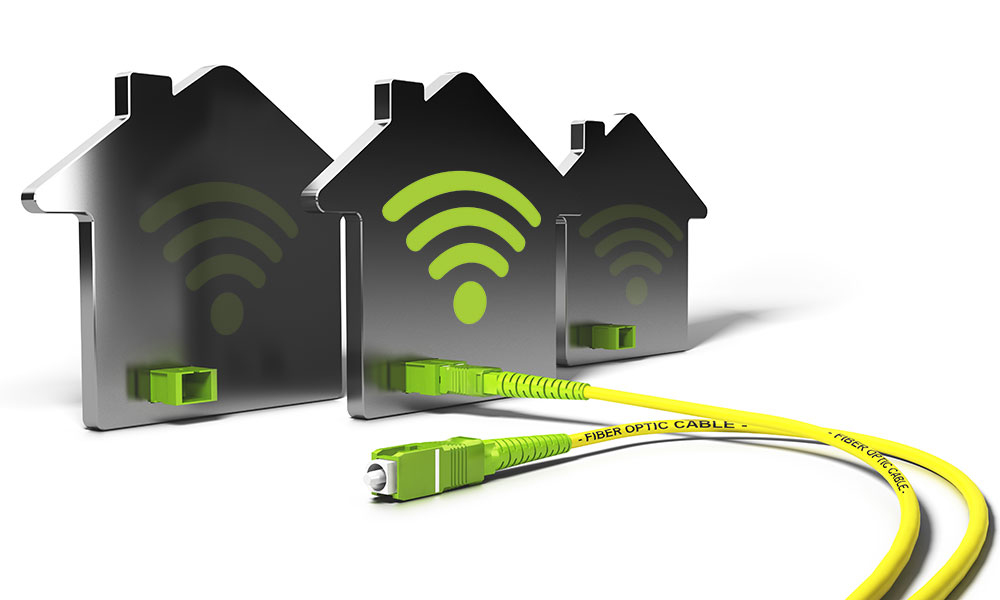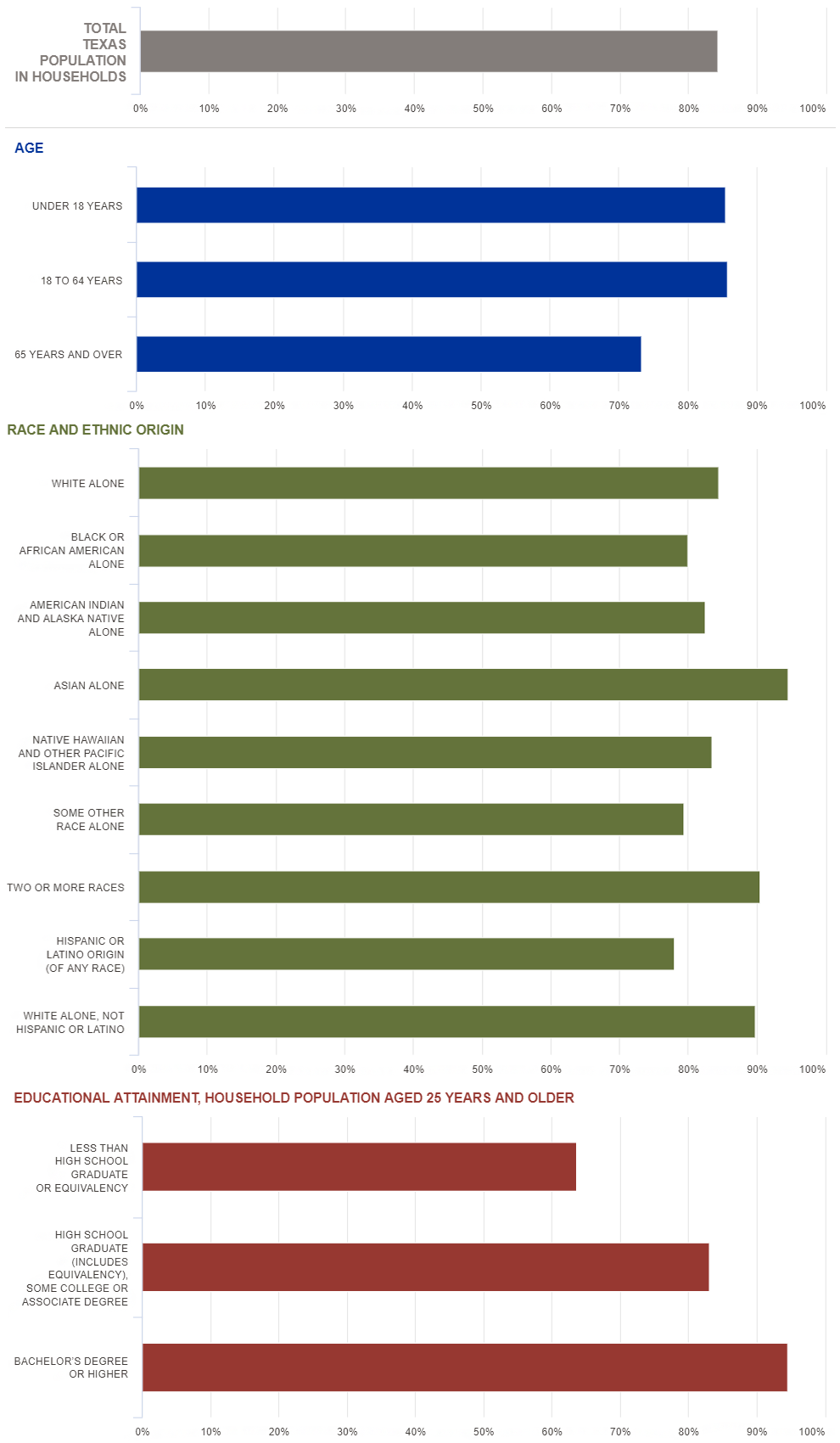
Broadband expansion in Texas – Bringing fast internet to more Texans
Broadband — an internet connection with sufficient speed to deliver online experiences including full-motion video without significant lag time — is increasingly seen as a requirement for modern life. In its 2010 National Broadband Plan, the Federal Communications Commission (FCC) stated that “like electricity a century ago, broadband is a foundation for economic growth, job creation, global competitiveness and a better way of life.”
In 2016, well before the pandemic, the Federal Reserve Bank of Dallas found that the gap between those with broadband access and those without (often called the “digital divide”) “leads to further economic, social and political disparities for low-income and underserved populations.” The COVID-19 pandemic likely has widened the economic gap between Texans who have broadband and those who don’t.
The Texas Utilities Code, mirroring the FCC, currently defines broadband as internet service capable of providing a download speed of at least 25 megabits per second (Mbps) and an upload speed of at least three Mbps. Six different types of broadband service are available in various areas (Exhibit 1).
EXHIBIT 1: TYPES OF BROADBAND SERVICE
- Cable internet is delivered via coaxial cable or a hybrid combining coaxial and fiber. Modern cable services can support speeds of up to 10 Gbps (10,000 Mbps) but generally offer slower service, such as 100 Mbps.
. - Digital subscriber line (DSL) access is provided through a local telephone network and offers speeds ranging from 1 Mbps up to 100 Mbps.
. - Fiber, a flexible, transparent conductor made of glass, permits transmission over long distances and at speeds of anywhere from 1 Mbps up to 10 Gbps.
. - Fixed wireless travels via radio broadcast from tall structures such as towers, water tanks, and rooftops. Fixed wireless services generally support speeds of between 1 and 100 Mbps.
. - Mobile wireless internet typically is offered at speeds comparable to DSL but often carries a bandwidth “cap” that limits the amount of data that can be used during a billing cycle.
. - Satellite internet service requires a small-dish antenna and satellite modem. One recently launched service offers speeds of up to 12 Mbps across most of the U.S.
Source: Connected Nation
Broadband in Texas
In December 2020, Connected Nation Texas, a broadband advocacy group, estimated (PDF) that 316,717 households in Texas were “unserved” by 25/3 Mbps broadband, about 89 percent of them in rural areas.
The issue isn’t limited to the countryside, however. According to the Census Bureau’s five-year estimates for 2015 through 2019, among U.S. metro areas with 500,000 households or more, the San Antonio-New Braunfels area ranked third-lowest in its share of households with broadband subscriptions of any kind, at 82.1 percent.
Even in urban areas with accessible broadband, many households still don’t subscribe to the service. “Cost is one of the main barriers to adoption,” says Jennifer Harris, state program director at Connected Nation Texas, “but some people don’t have digital literacy skills or access to a device, and others choose not to have the internet in their home due to privacy concerns; still others are denied broadband service because of missed payments.”
In the census estimates, Texans identifying as white alone were more likely to have broadband than those identifying as Black or Hispanic. Those with college degrees were more likely to have it than those with less education (Exhibit 2).
EXHIBIT 2: PROFILE OF TEXANS WITH BROADBAND SUBSCRIPTIONS, 2015-2019 CENSUS ESTIMATES

Broadband expansion was gaining political momentum well before COVID-19 struck (see October 2019 Fiscal Notes).
The pandemic, which immediately boosted demand for broadband-enabled services, has pushed this expansion to the forefront of the legislative agenda.
Gov. Greg Abbott prioritized it as one of his five emergency items for the 2021 session in his State of the State address on Feb. 1.
“The pandemic has shown everyone how important broadband is,” says Harris. “Ten years ago, we had to tell people why broadband would be good for the community. We don’t need to tell anyone that anymore.”
The upheaval caused by COVID-19 has made the importance of widespread high-speed internet access painfully obvious, particularly for purposes such as distance education, telehealth, and telemedicine services, and e-commerce.
Education: When Texas’ public schools first closed in March 2020, the Texas Education Agency (TEA) scrambled to help students connect to their virtual classrooms. Early in the pandemic, a survey of the state’s educators indicated that one in six Texas students lacked high-speed internet access, and 30 percent didn’t have a “dedicated and adequate learning device.”
To meet the sudden need, TEA and the Governor’s Office agreed in May to scale Dallas ISD’s Operation Connectivity, which aimed to supply devices and internet access to students who needed them, into a statewide operation.
As of January 2021, education officials had purchased or reimbursed school districts for more than 4.5 million devices and Wi-Fi hotspots, with contributions from TEA, local districts, and business partners, and more than $600 million of Coronavirus Aid, Relief, and Economic Security (CARES) Act funding. (A hotspot is a public site offering wireless internet.)
The effort has included equipping some districts’ school buses as mobile hotspots. Future project phases will include greater and more targeted assistance for economically disadvantaged students, bulk-pricing negotiations with internet service providers (ISPs), and the exploration of additional broadband technologies particularly useful for school districts.
Universities and colleges also shifted online and had to cope with many students’ substandard internet access. Difficulties caused by the shift to online learning likely contributed to a 3 percent decrease in Texas higher educational enrollment for fall 2020.
As of Nov. 20, moreover, federal college aid applications by high school seniors, an important indicator of their plans, were down 14.6 percent from the same period in the previous year. Educators are working to connect more closely with students so the pandemic doesn’t further derail their education.
Health Care: The higher demand for health care during the pandemic, as well as the risk of contracting COVID-19 through in-person office visits, led to an enormous rise in telehealth services, including online clinical visits as well as patient and professional health-related education.
According to the Texas Association of Health Plans, 4.5 million Texas residents began using telehealth services during the pandemic and 94 percent say they plan to continue using them after the crisis subsides.
In March 2020, Gov. Abbott issued a number of executive orders to make virtual doctor visits easier, including the suspension of copayments for telehealth, full insurance coverage for telehealth visits, and expanded qualifying options.
The governor and lawmakers, including current House Speaker Dade Phelan (R-Beaumont), consider telehealth among the top priorities for the 2021 legislative session.
E-commerce: The amount of retail commerce shifted online during the pandemic has been staggering. More than ever, customers and businesses rely on solid internet connections for online shopping and curbside pickup.
According to census data (PDF), national retail e-commerce sales in the fourth quarter of 2020 totaled $206.7 billion.
In Texas, year-over-year sales tax revenue from online shopping rose by 41.6 percent in November 2020 and 40.0 percent in December.
Those figures include vendors specializing in online sales but not the e-commerce components of businesses with brick-and-mortar stores, many of which also have seen huge online sales increases.
Broadband Planning
All 50 states have recognized the importance of broadband by establishing authorities, task forces, advisory councils, or similar entities to oversee expansion efforts.
Texas broadband planning began in earnest in 2019, when Gov. Abbott formed the Governor’s Broadband Development Council.
In September 2020, a bipartisan group of 88 Texas legislators sent a letter to the governor stressing the need for a state broadband plan. Two months later, the council formally recommended (PDF) that legislators create a state broadband plan and a state broadband office.
The council’s report “did a great job framing what [lawmakers] can tackle this session,” says Harris. “It gives them guide rails without being overly prescriptive.”
According to Connected Nation Texas (PDF), broadband plans “define goals and objectives, identify steps to achieve them, help guide state investments, provide a baseline against which to measure progress, and provide a framework for local planning efforts.” A state broadband plan also seeks to maximize federal funding for its implementation.
The Broadband Development Council reported that (PDF) Texas is one of only six states without a broadband plan. As of May 2020, about three-quarters of U.S. states had created a broadband office to coordinate planning and implementation efforts.
In Minnesota, for instance, the Office of Broadband Development, established in 2013 and housed in the state’s Department of Employment and Economic Development, is responsible for promoting statewide broadband expansion to fulfill certain economic and accessibility goals.
Several Texas bills to accomplish some or all of the Broadband Development Council’s goals have been filed in the current legislative session, including companion bills by Rep. Trent Ashby, R-Lufkin (House Bill 1446), and Sen. Robert Nichols, R-Jacksonville (Senate Bill 506), which would house the broadband office within the Comptroller’s office.
.
Funding Broadband
The costs of broadband infrastructure vary greatly by location, geography, and type of connectivity. For instance, fiber-optic service costs much more than traditional cable or DSL connections offering lower broadband speeds.
Many of the barriers to expansion in Texas concern the state’s size, varying population densities, and even its terrain. Wireless service, for example, can be more effective in the plains of West Texas than in the forests of East Texas, which can interfere with signals.
ISPs lack incentives to expand broadband service in many rural areas, simply because it isn’t very profitable. The costs associated with connecting end users to the internet network generally are much higher in areas outside cities.
In 1987, the Texas Legislature created the Texas Universal Service Fund (TUSF) to support state programs that incentivize the development of telecommunications services in certain rural and low-income areas.
Broadband service isn’t currently eligible for this funding, but at least one bill introduced during the 2021 legislative session would expand the use of the TUSF to include broadband.
According to the Pew Charitable Trusts (PDF), as of May 2020, 27 states had established funds to help expand broadband service, although not all of them were active.
The federal government also provides support for broadband expansion. In 2018, the U.S. Department of Agriculture initiated the Rural Development Broadband ReConnect program, a pilot program providing eligible entities (including ISPs and state and local governments) with loans and grants to build rural broadband infrastructure.
In the following year, the FCC established the Rural Digital Opportunity Fund to provide $20.4 billion to connect more rural households and small businesses to fixed broadband service.
On Dec. 7, 2020, the FCC announced that Texas would receive $362.7 million from the fund during the next 10 years to serve nearly 311,000 rural households and small businesses in the state.
In addition, both the March 2020 CARES Act and December’s Coronavirus Response and Relief Supplemental Appropriations Act (CRRSAA) included funding for expanding broadband access.
Among the provisions in the CRRSAA was $3.2 billion for the Emergency Broadband Benefit Program, which would partially reimburse ISPs for the costs of expanding broadband service to low-income or underserved communities.
For more on Texas broadband issues, visit Connected Nation Texas. This story originally published by the Texas Comptrollers Office.






